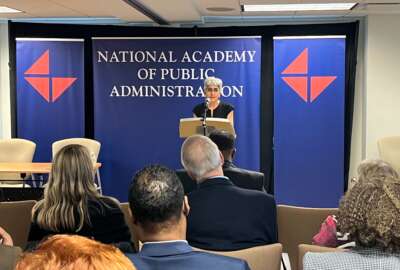
Feds in Gen X and Gen Z both want more work flexibility, but often for different reasons
Looking at the differences — and similarities — of federal employees in Generations X and Z could help agency leaders better understand how to improve workforce...
Best listening experience is on Chrome, Firefox or Safari. Subscribe to Federal Drive’s daily audio interviews on Apple Podcasts or PodcastOne.
Improving retention of federal employees is a long-standing challenge for agencies, but the way to incentivize feds to stay in public service may differ, depending on their age.
Although federal employees in Generation X, born between 1965 and 1980, and those in Generation Z, born between 1997 and 2012, both value flexibility in a workplace, they seek it out for different reasons.
Many Gen Z employees entered the workforce after the start of the COVID-19 pandemic, making remote work flexibilities practically essential to them, according to Paul Pietsch, senior manager for federal workforce research at the Partnership for Public Service.
“Working in a hybrid way, working remotely, or working with workplace flexibility is baked into the equation. It is what’s usual, [and it’s] what they expect. That is the status quo. And if it ceases to be status quo, that could present challenges. If agencies decide to come fully back to work and to forego any remote work, any hybrid work, I think that could push some younger employees out of government to the private sector. And I think it could turn off other young people from considering a career in government, or a career with a specific agency,” Pietsch said in an interview.
For many younger federal employees, remote work is about more than just the ease of not having to go into the office, according to a Nov. 14 report from the Partnership, with support from ServiceNow, focusing specifically on retention challenges for Gen X and Gen Z federal employees.
“The young people we spoke with often described remote and hybrid work as an emblem of trust, of respect, that it showed that their leaders knew they could do the work, and could do it without in-person supervision on a daily basis. And they valued that. So I think that’s something to keep in mind for leaders,” Pietsch said.
Gen X employees also said they valued flexibility in their workplace policies, but often for different reasons. For many in that age group, remote work and telework options helped them better address family needs. But at the same time, the flexibility that remote work allows may lead to more hours of working. Notably, according to the Partnership’s Best Places to Work in the Federal Government rankings, feds between ages 40 and 59 had the most negative perception of their work-life balance out of any age group in the federal workforce.
An aging workforce
The new report from the Partnership also comes at a critical time for the federal workforce, which is, on average, older than the nationwide workforce. Notably, 1.6% of the federal workforce is Gen Z, compared with 9.1% in the private sector. Comparatively, Gen X feds comprise 41.6% of the federal workforce, and just 31.6% of the private sector. That means Gen X employees are overrepresented and Gen Z employees are underrepresented at agencies, the Partnership said. But the breakdown of age groups in the federal workforce will not necessarily be around for the long-run, Pietsch said.
“I do think that 1.6% number will go up,” he said. “And I think at this point, its comparison to the overall labor force, it’s a little hard to draw too much out of that, because there’s so many unknowns. But nonetheless, it is unnerving, because as more and more baby boomers are hitting retirement, and Gen X is approaching retirement, we definitely need younger people coming to the federal service.”

It’s a challenge that may eventually hit the federal sector particularly hard. Nearly 30% of the federal workforce will reach retirement age within the next couple of years. And according to a separate report from the Equal Employment Opportunity Commission released earlier this year, 72% of federal employees are over the age of 40, compared with just 54% of workers in the private sector in the same age group.
“That really underscores how much older the federal workforce is than the private workforce,” Pietsch said.
What do Gen X and Gen Z feds seek out?
Other than flexibility, there are several other factors influencing the retention of Gen X and Gen Z employees in the federal workforce, including financial incentives, connection to mission and an inclusive workplace.
“These and other retention factors are often interconnected, however, and they should not be treated as independent variables,” the report said. “Moreover, the factors highlighted in this report influence Gen X and Gen Z retention in various ways and to different degrees.”
For financial incentives, for instance, although there are limited ways for agencies to offer higher wages to federal employees, the promise of full retirement benefits was a significant influence for Gen X employees to remain in federal service. For Gen Z, on the other hand, incentives such as the Public Service Loan Forgiveness program were a stronger motivating factor, the report said.
Another challenge impacting federal workforce retention for Gen X was that many employees in the age category are struggling to move into the Senior Executive Service. In 2021, civil servants ages 55 and older comprised 29.1% of the workforce, but 53.3% of the SES. In comparison, Gen X feds make up 41.6% of the federal workforce and 44.3% of the SES, revealing a disparity in their representation in senior-level positions.
But Pietsch said that may not necessarily lead to staff attrition — it’s a frustration for many Gen X employees, according to focus groups that the Partnership conducted, but it’s not a reason that most employees said they would actually leave their jobs.
“Nonetheless, it’s very important for leaders to consider and to think about how they can support their Gen X civil servants in other ways to ensure that they are continuing to advance professionally and continuing to develop leadership skills, so they are prepared to assume SES roles when become available, but also, so they can continue to be good leaders and thought leaders outside an SES role,” Pietsch said.
In the meantime, agency leaders can still support Gen X employees who don’t yet have a clear path toward the SES. For example, agencies can either newly establish or more strongly encourage employees to take part in a senior executive candidate development program. Many rotational programs are also available not only to Gen X employees, but to all federal employees.
“There’s [also] the opportunity to do rotations, details, exchanges, what have you, outside of the federal government,” Pietsch said.
Despite some of the differences between the two generation’s workforce values, Pietsch said one thing they frequently had in common was connection to agency mission — but that’s not all. Even though the report largely focused on differences between the two age groups, there was still plenty of overlap.
“Gen Xers and Gen Zers … value good communication with their leaders, respect within the office, a reliable and consistent workplace, supervisors who are accountable, opportunities to grow professionally, and working with colleagues who are competent,” Pietsch said.
Copyright © 2025 Federal News Network. All rights reserved. This website is not intended for users located within the European Economic Area.
Drew Friedman is a workforce, pay and benefits reporter for Federal News Network.
Follow @dfriedmanWFED
Related Stories





